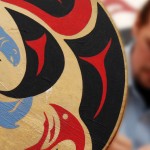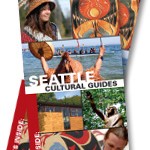Source: Visit Seattle

The ubiquitous totem pole, the most visible example of Native artwork in Seattle, actually comes from Southeast Alaska and British Columbia.
Since the Klondike Gold Rush of 1897, Seattle has had close ties to the Northwest Coast, and many monumental works of art from Haida, Tsimshian and Tlingit carvers can be seen in Seattle.
Totem poles were traditionally carved from cedar trees to serve as memorial posts displaying inherited crests, or as house posts providing support for large cedar long houses.
These monumental sculptures feature stylized animals and animal-spirits such as Bear, Beaver, Raven, Frog, Killer Whale, and many others which play important roles in traditional stories and have been associated with family clans reaching back many generations.
Traditional totem poles are on display at the Burke Museum, Victor Steinbrueck Park, Pioneer Square, and other parks and viewpoints around the city. Contemporary artists throughout the Pacific Northwest have adopted this form, and examples of their work can be seen in many museums and galleries.
Coast Salish artwork, the traditional style of the Puget Sound area, features more subtle and personal designs. Local traditions included carved objects such as house posts, which were both decorative and functional. House posts were typically found inside of large plank houses as part of the framing structure, rather than outside on public display.

Small items such as spindle whorls and canoe paddles were both utilitarian objects and ornately carved artworks. Twined baskets, as well as hats and clothing were made from cedar, and elegant blankets and robes were woven on large looms using yarns spun from the hair of mountain goats and woolly dogs.
Local design traditions have been overshadowed for generations by more dramatic artistic styles from farther north, but Coast Salish aesthetics are being revived by contemporary artists such as Susan Point, Roger Fernandes, Andrea Wilbur-Sigo and Shaun Peterson.
These and other Native artists drawn on traditional styles, and incorporate new materials such as glass and metal, to create work that is increasingly visible in Seattle’s galleries, museums, and public artworks.
Did You Know?

Large terra cotta cartouches featuring a stylized portrait of an Indian elder are found in several locations throughout Seattle. Oddly, the figure’s traditional feathered head dress is associated with tribes from the Great Plains region, rather than the Pacific Northwest, and was perhaps inspired by photographer Edward Curtis to symbolize the grandeur of the West, rather than to depict local historical reality.
These architectural ornaments were part of the 1909 White Henry Stuart Building, which once stood at Fourth Avenue and University Street. When that building was demolished, the terra cotta artifacts were salvaged and are now on display at the Convention Center, the Museum of History and Industry, Daybreak Star Indian Cultural Center and other locations.
For more Native American culture and other cultures found around Seattle, check out Visit Seattle.

